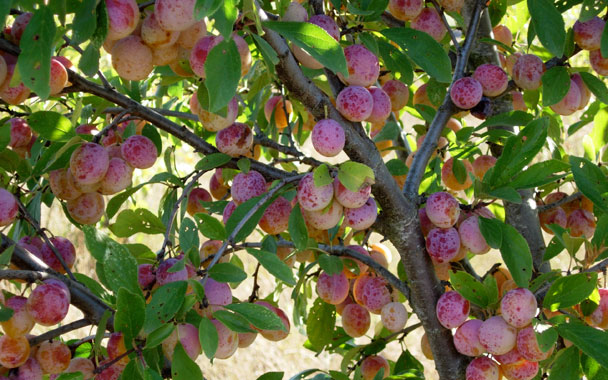In New Mexico, our local plums are often picked so green that the flesh is crisp instead of melting, and tartness pervades every bite. When cooking with them, the tannins fairly leap out of the skins, and in goes the sugar to achieve balance. If you try to play it safe by shopping at the store instead of the farmers market, odds are you’ll discover that the “red plums” and “black plums” found there are consistently bland, dry, and mushy. It’s enough to make a person give up on plums!
Being a transplanted Californian and a diehard fan of Luther Burbank’s lush little Santa Rosa plum, I can’t give up. I know that there are good plums out there, and this month I was fortunate enough to taste some exceptional ones. While in Oregon for a few days, I took an opportunity to pay a visit to my favorite farmer, Anthony Boutard of Ayers Creek Farm. Anthony and his wife, Carol, are mid-career farmers but longtime plant people and growers in Portland’s community gardens. They grow some odd but interesting edibles that they sell at the Hillside farmers market, but many of their 144 acres are given over to blackberries, raspberries, and their relatives. On this visit, however, we went to straight to the plum orchard.
“Have you ever had a Coe’s Golden Drop?” Anthony asked as he waded into a row of trees and picked our first plum. I hadn’t. Big, oval, and golden within and without, the aptly named fruits marched down the thin branches of young trees just like big, golden drops. Here was a juicy, sweet plum as luscious as an apricot, which is to say, stunningly good. According to Steve Facciola’s notes in Cornucopia II: A Source Book of Edible Plants, Coe’s Golden Drop is regarded as the Cox Orange Pippin of the plum world, or the Comice, if you wish a comparison to pears. Such reactions aren’t surprising. My sticky, juice-covered notes simply say, “Like candy, only better!”
We went on to taste some Gages, Anthony’s sworn favorite, considered the gold standard of plums by connoisseurs. Green Gage is best known, but Anthony reached for a Violette instead, a light-purple variety speckled with gold. It’s a pretty fruit, round and on the small side, with firm, greenish flesh: another perfect plum with sweetness pervading, but just enough acid to make it all come together in the mouth.
Next, Anthony picked a handful of very small, round Mirabelles. They are yellow-fleshed, with yellow skin splashed with rose and pink. Mirabelles are most often used for canning and in compotes and other cooked desserts, but they’re a delicious and lovely little plum to eat out of hand as well. The fact that they don’t drip too much juice can be handy if they’re intended as a roadside snack.
We went on to sample a prune plum called Seneca, the French prunes d’Ente and the famous d’Agen, then two others called Brooks and Fallenberg—all blue, oval fruits with yellow or greenish flesh. They’re rich, dense, and not as juicy as other varieties—exactly the characteristics you want in a plum that’s to be dried. (The same holds true for plum tomatoes.)
Before we left Ayers Creek, Anthony dashed back to the orchard and filled a paper bag with plums for us to eat as we continued on our drive. As each day warmed, the car filled with their perfume. At night, we brought them into our room and put them in a bowl. What a stunning array of colors: blue, violet, purple, yellow, gold, and red; some covered with bloom, others with blushes of color, and still others stippled with tiny sugar dots. Some were large, some tiny; some oval, others round. It was a jumble of fragrance and color and flavor.
The Boutards sell their plums, berries, grapes, and other foods at the Hillsdale farmers market, near Portland, every Sunday. But see what’s growing where you live and look for those that show promise and are new to you. And be sure to ask for their names so that if you like them, you can ask for them again. There is a world out there that is far more interesting and diverse than the narrow world of red and black plums, and every bite helps keep that happy diversity alive for us to enjoy.




 Pinterest
Pinterest


